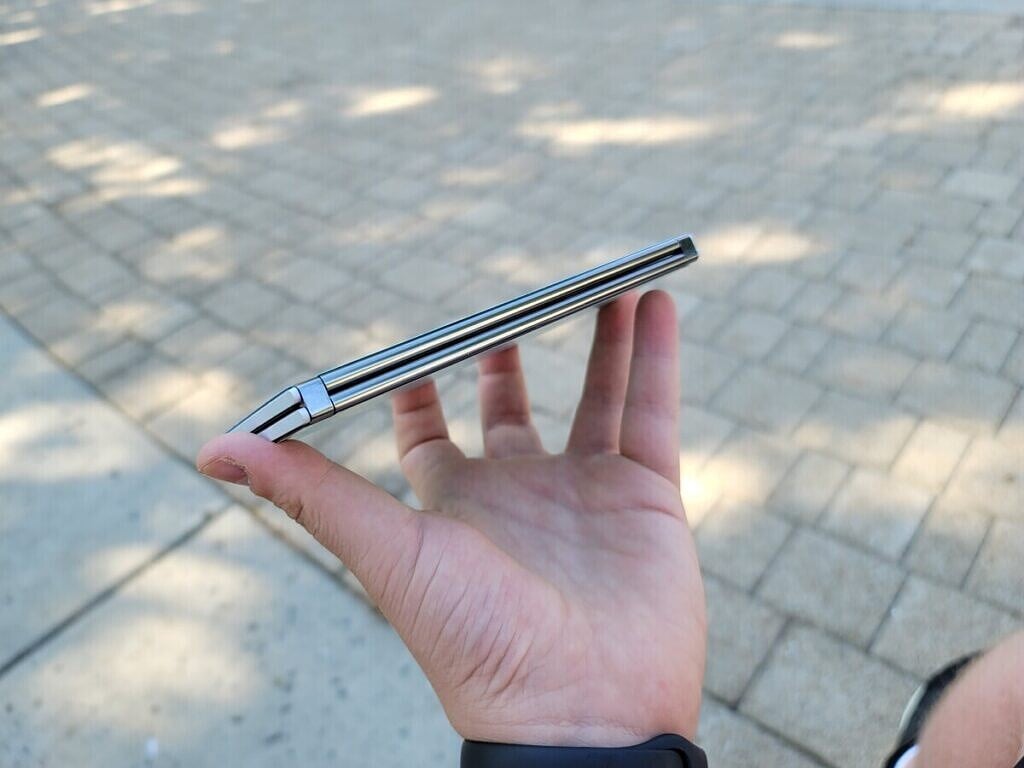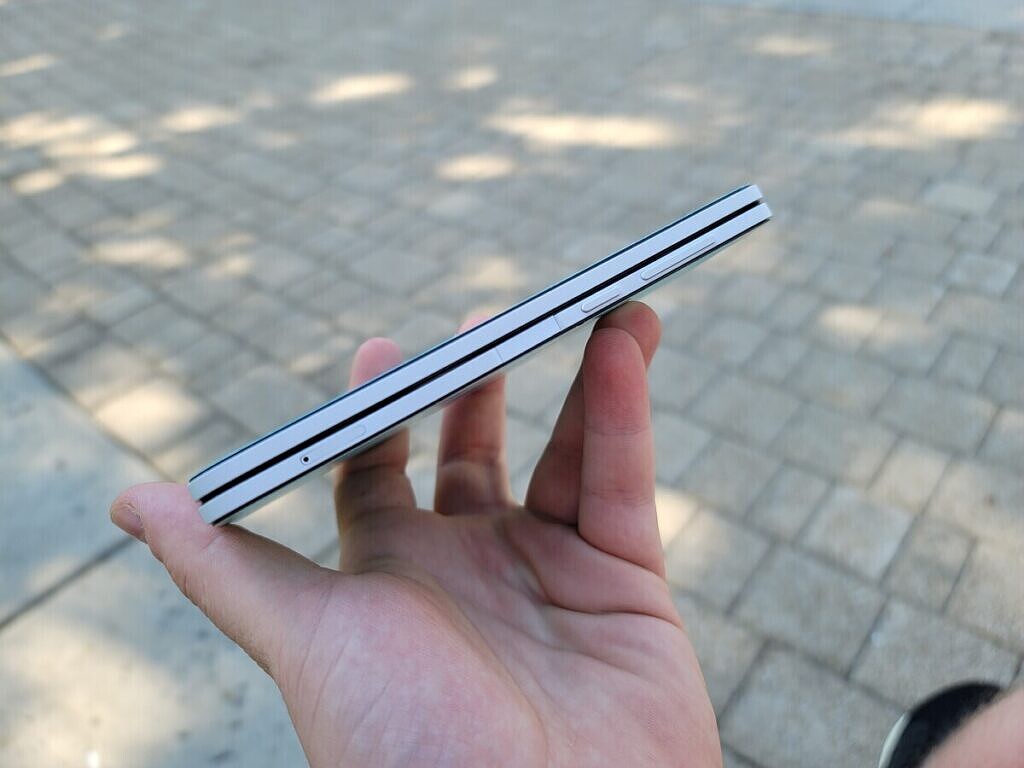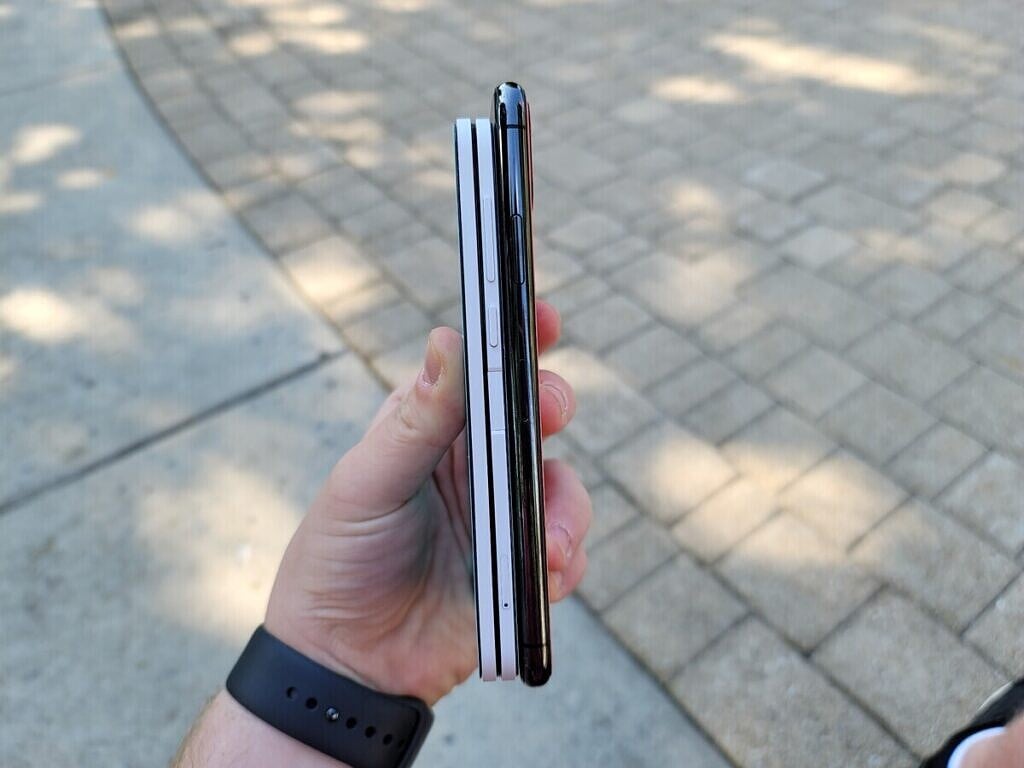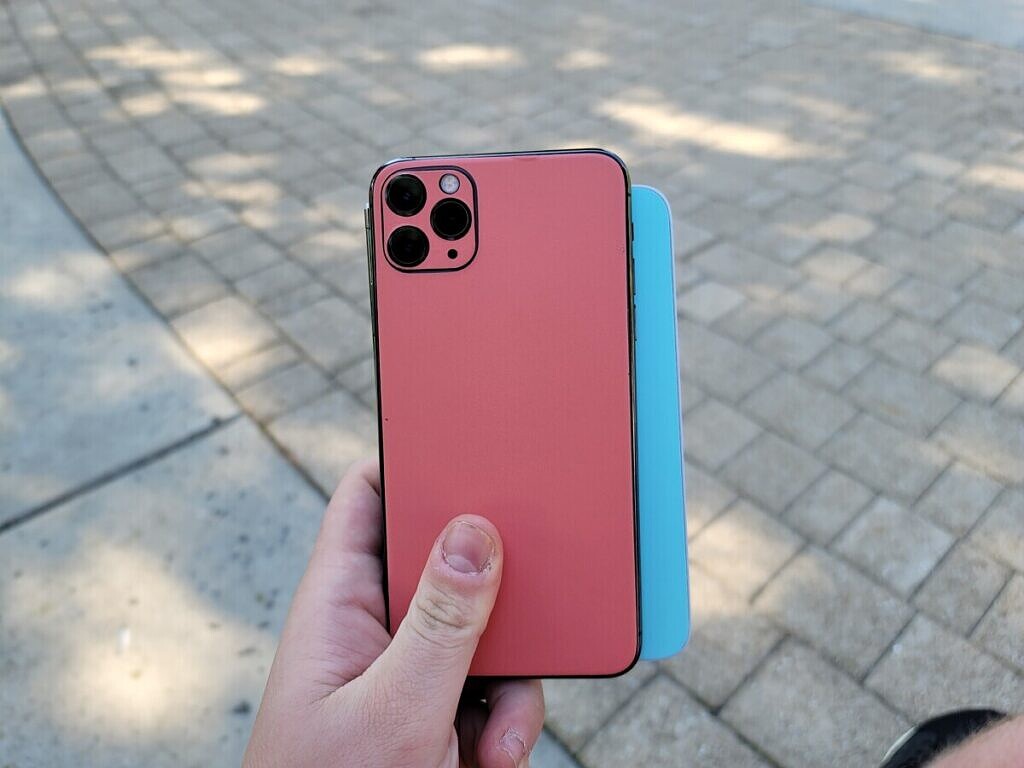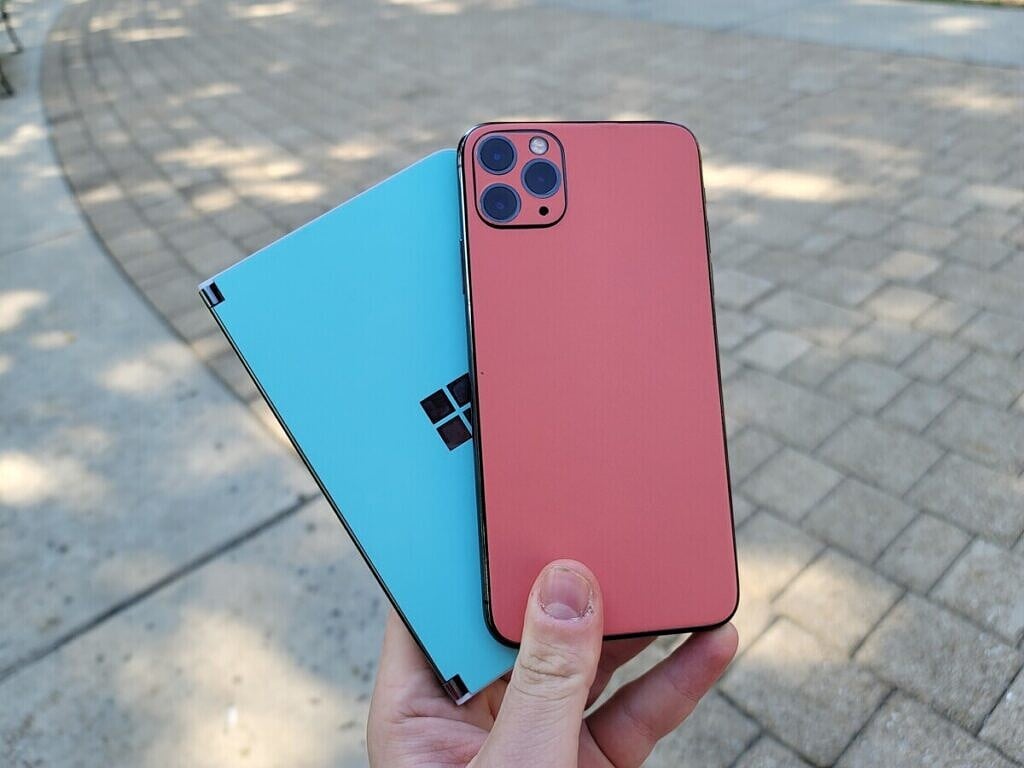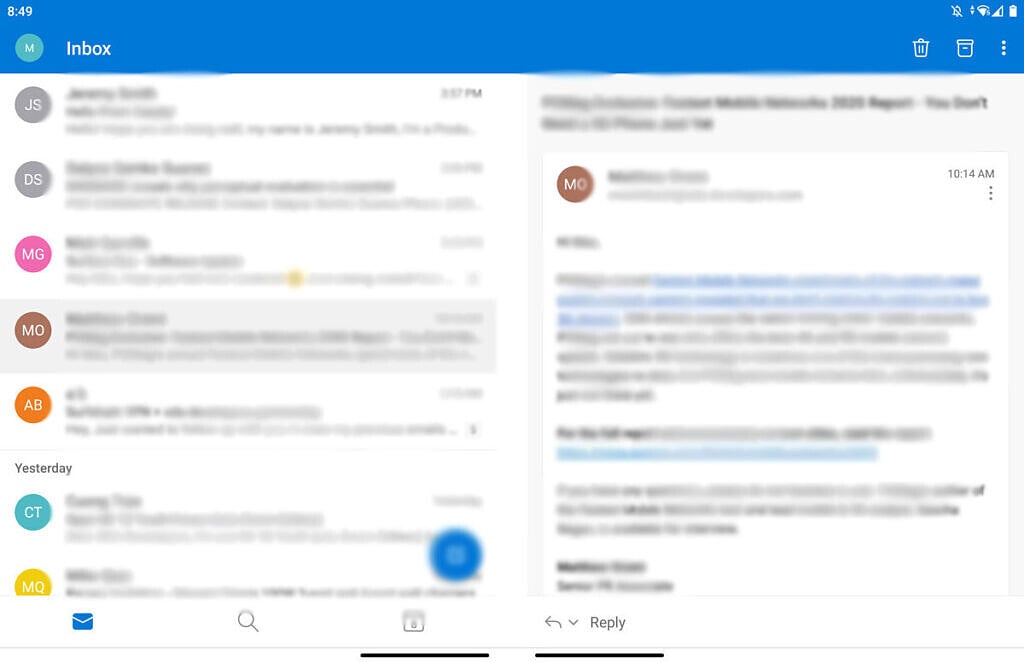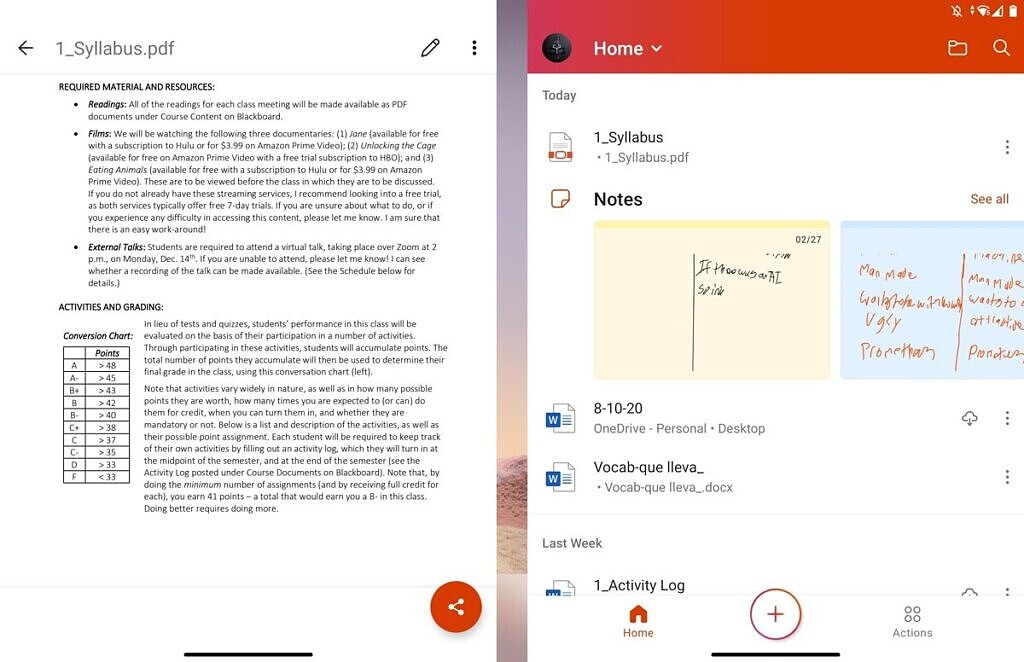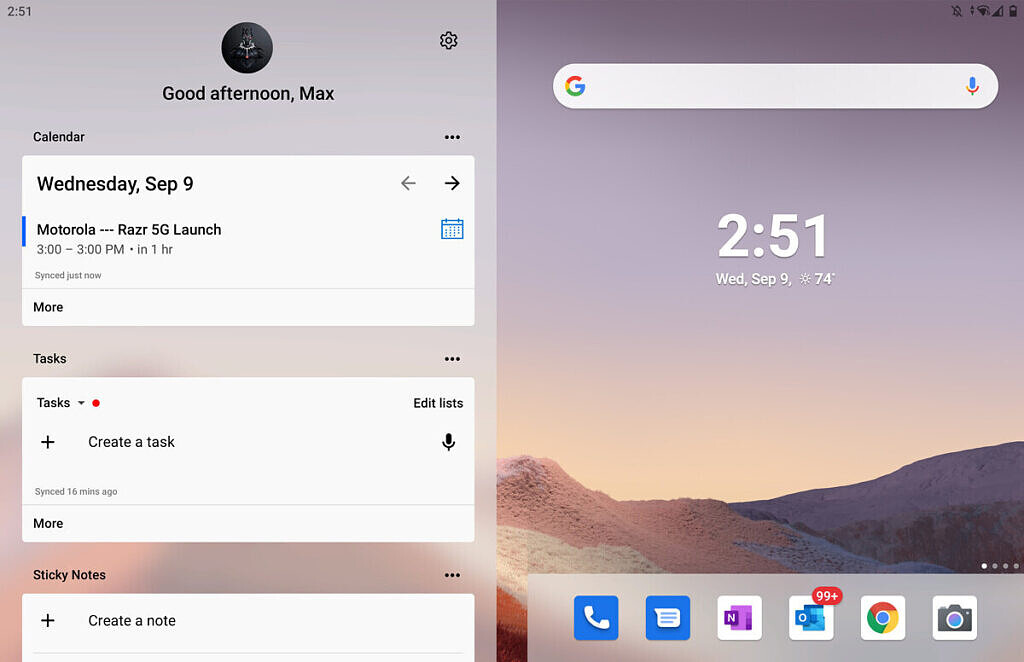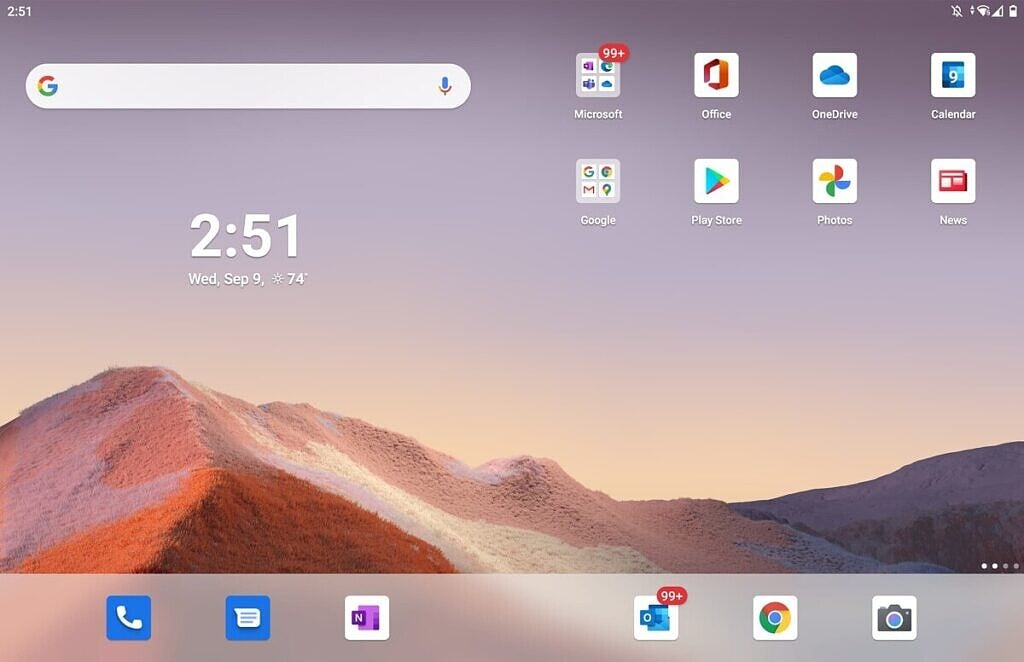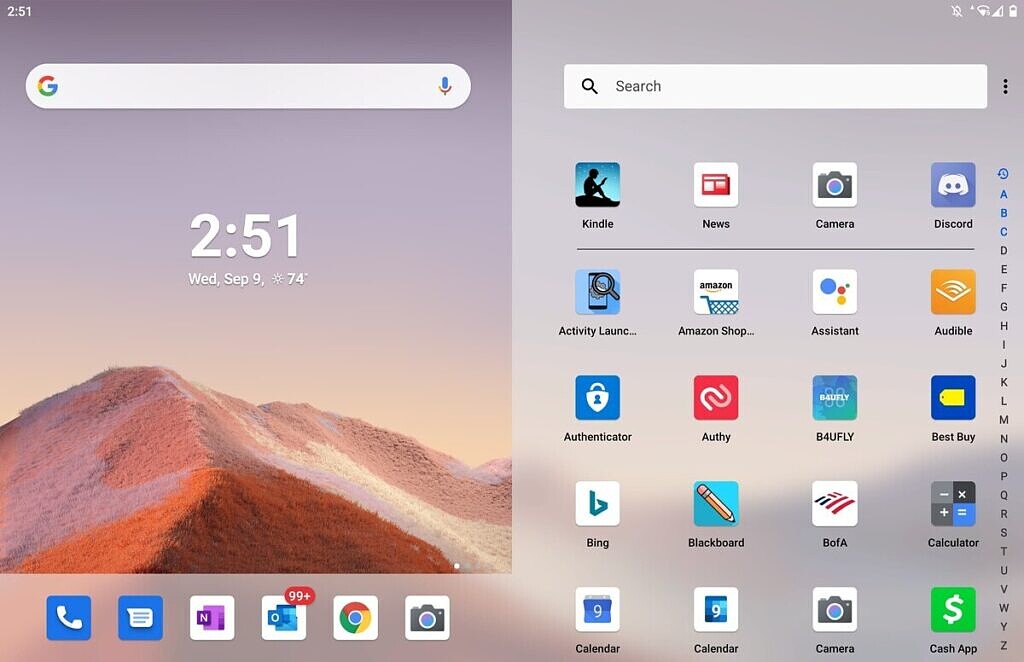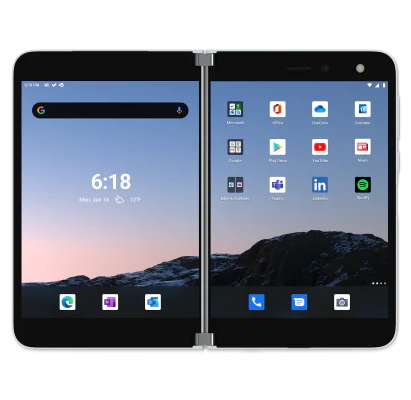The Microsoft Surface Duo is probably one of the most interesting devices to launch this year. In a world of Galaxy Z Fold and Flip, the dual-screen approach might seem uninteresting. And at first, I thought it was too. It seems like two phones just stuck together. The device may not seem all that interesting purely from the hardware spec sheet or the software, but it does pull together an exciting experience that isn’t very common across Android yet. After 2 weeks of using the Surface Duo, I see the phone much more differently. Let’s talk about it.
Microsoft Surface Duo: Specifications
| Specifications | Microsoft Surface Duo |
|---|---|
| Dimensions & Weight |
|
| Display |
|
| SoC |
|
| RAM & Storage |
|
| Battery & Charging |
|
| Camera |
|
| Connectivity |
|
| Security & Authentication |
|
| Pen & Inking | Supports all in-market generations of Surface Slim Pen, Surface Pen and Surface Hub 2 Pen |
| Audio |
|
| Exterior |
|
| Android Verison | Android 10 with Microsoft Surface Duo UI |
| Price | $1,399 |
Okay, let’s hold off on the talking real quick to talk about something else that’s also important. The Microsoft Surface Duo is not a foldable phone. While it does some “folding”, it falls short on the premise of a true foldable, like the Galaxy Z Flip or Galaxy Z Fold 2 or Huawei Mate Xs or Moto Razr. Instead, the Surface Duo is best described as a dual-screen phone. Many people assume having a hinge makes it a foldable, but it does not. As Microsoft has said, it’s a phone that is meant to keep you in your flow. There is no need to close apps when you need to switch tasks as you would on a normal phone, but instead, just open it on another screen. This is a big point, even if it doesn’t seem like it on the surface.
Hardware
So first and foremost, the hardware. It’s not only one of the most important parts of the device, but it explains the entire experience Microsoft is pushing with the Surface Duo. The internals aren’t particularly impressive for a 2020 flagship as you can see in the spec sheet above, but there is so much more to it than that. To say I’m impressed by this “outdated” hardware would be an understatement.
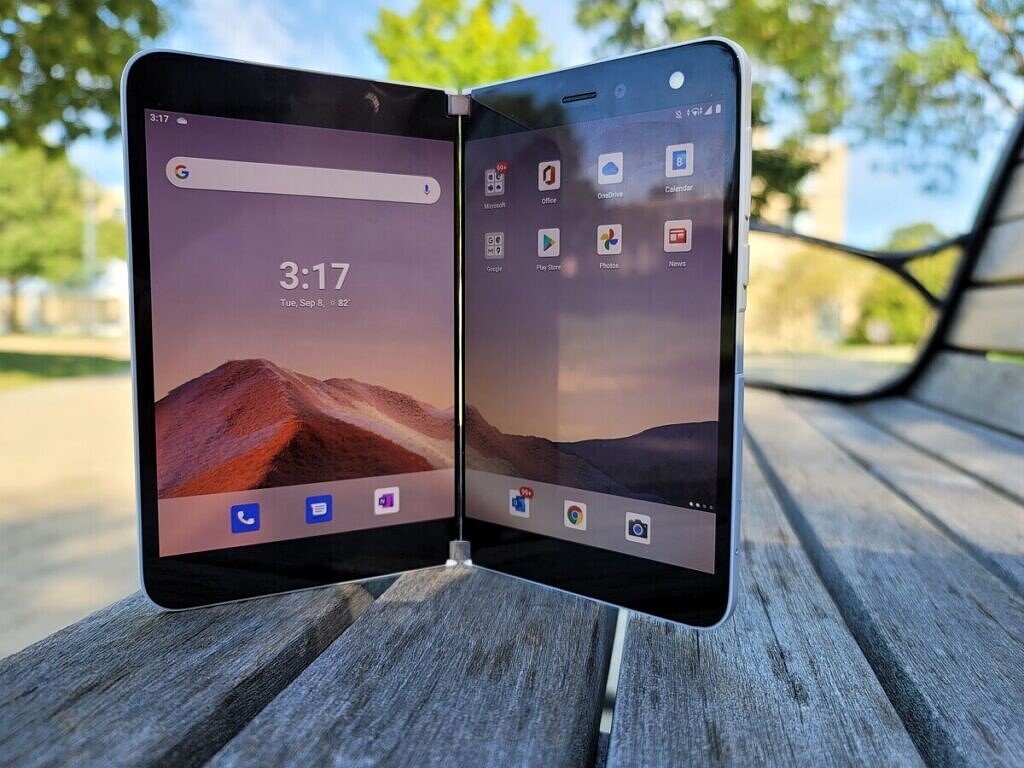
So first let’s talk about the displays. There are two 5.6” AMOLED PixelSense Displays with a display resolution of 1800×1350 and aspect ratio of 4:3 each. When rotated, it acts like one 8.1″ tablet. Both displays do support the Active Pen which means full Surface Pen support across the entire lineup of Surface Pens. I’ve been using the Surface Slim Pen and a classic Surface Pen with my Surface Duo and both have been fantastic. It’s a weird mechanic but it’s actually pretty great for scrolling through Twitter or just trying to show off the phone. It’s a very eye-catching phone and I found a lot of people were interested in it, especially when it was in the larger 8.1″ tablet mode.
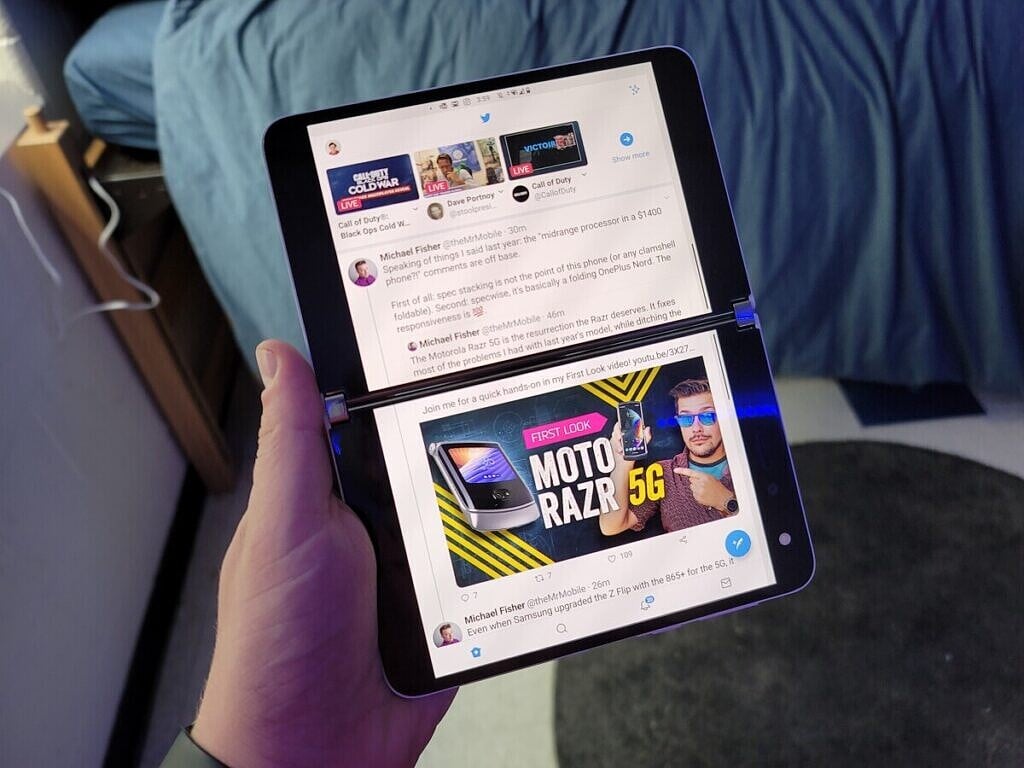
The next thing to mention is the overall body. It’s one of the most impressive designs I’ve seen on a phone, and this is coming from someone who has used a lot of impressive phones over the years. The body of the phone is a custom material. To put the phone together, Microsoft slides the body of the phone around the internals then sandwiches the device in Gorilla Glass. There are no antenna bands or seams to be spotted on the body, each side appears as one solid piece. Microsoft also said one of the most important things for them was the thickness of the phone, while accounting for RF pass-through as well as durability, and a few other things. The Surface Duo is really thin, only being slightly thicker than the standard USB Type-C port on it.
The next thing worth mentioning is the hinge. It’s a fully metal hinge that can basically stay in any position in its full 360° rotation. You can use it like a book, tent, laptop, and more. Basically, any way you could think about folding it, the Duo will let you fold it, and it will stay in place. It’s super versatile and useful. The flexibility of the hinge and versatility of the device is one of the reasons I love the Microsoft Surface Book 3. The hinge itself is great, with a very good feeling to it. It has the perfect amount of tension that makes folding feel great. It’s not too tight but at the same time not too loose – just simply perfect! Dare I say, it’s probably the best hinge I’ve felt on any modern piece of tech. It’s just so good.
Now to the less important parts of the design, the glass. I only mention glass because there are 4 separate pieces of glass on the Surface Duo. The two displays are, of course, protected by Gorilla Glass, but so are the exterior pieces. The exterior pieces come with a light gray colorway and that’s about it. At first, I was confused about why Microsoft would make it glass on the outside if it didn’t have wireless charging. After all, it’s 4.8mm thin while unfolded and must be prone to breakage. After speaking to Microsoft a bit, the reason for glass ended up making sense. It’s for the RF connectivity. Microsoft had made it clear that the radios and antennas on a device this thin and foldable were difficult to execute. Unlike a normal phone, you need to separate them into both halves and make sure everything is still within FCC limits. It would have been nice if the back was magnesium like on the Surface Book 3, but honestly, I can’t complain about the glass too much. It makes sense that they’re using it. And if you are still worried, the Surface Duo comes with a bumper in the box for protection.
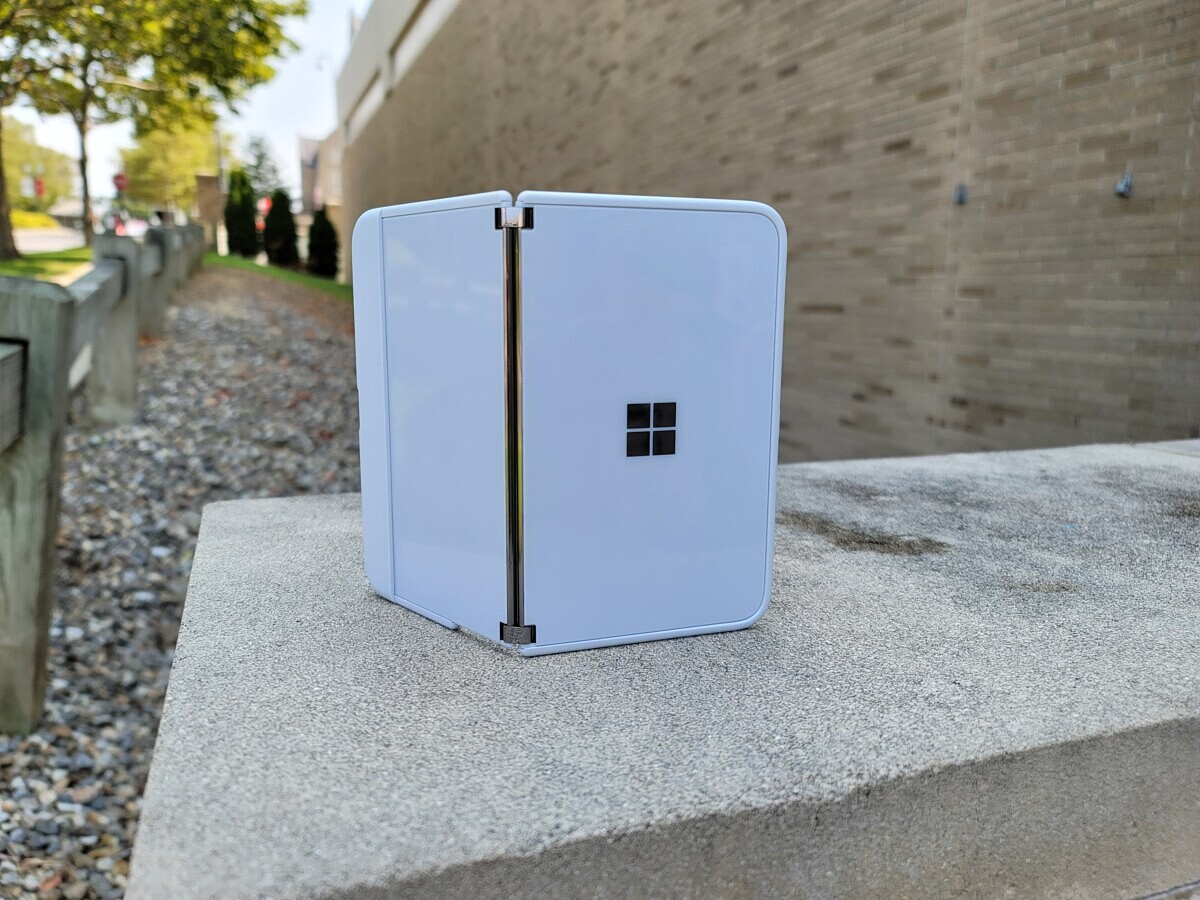
Speaking of the bumper case, you might want to keep using it. A few other reviewers I’ve spoken to that didn’t use the bumper case have noticed some discoloration of the buttons after about a week. I used the bumper for about a week then ended up taking it off. I haven’t noticed discoloration quite yet on my unit, but I thought it was also worth mentioning considering that the device will cost you a pretty penny.
Also, it’s worth mentioning that while the device looks big, it really isn’t. It easily fits in my pocket and it’s actually a pretty great size. It’s not too much bigger than the iPhone 11 Pro Max, which fits well in most pockets. I know that was a concern for a lot of people while looking at photos, but it wasn’t an issue for me.
The one thing I don’t like about the glass is the color. I find the light gray to be particularly boring and frankly not as interesting as the device itself. A few of the other Surface signature colors like Cobalt Blue or Sandstone or even just Black would have been nicer. Don’t get me wrong, the Glacier gray of the Surface Duo is fine, but I ended up throwing a skin on it because it was just more interesting and looked better.
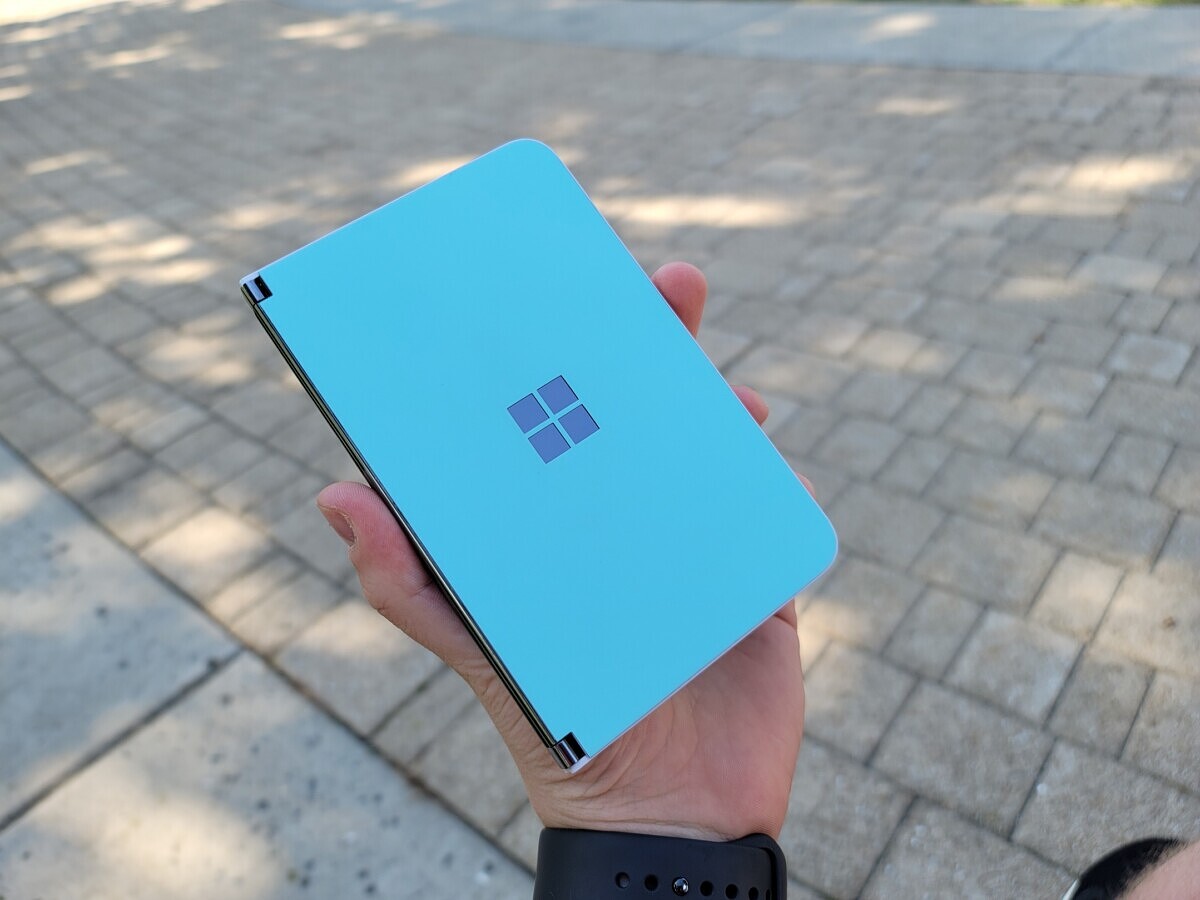
With hardware, we also have to talk about some of the specs and the battery. For the internal specs, we have a Snapdragon 855 “optimized for dual-screen experience,” 6GB of RAM, 128GB or 256GB of UFS 3.0 storage (my unit is the 256GB model), and a 3577 mAh battery with 18W fast charging. It has a single mono speaker and a single earpiece speaker, but these are not the same speakers and there is a definite difference between the two.
As for battery life, it lasts me about a day. Your mileage may vary, of course. Unfortunately, Microsoft decided not to include wireless charging, but this was likely because of the thickness of the device. It’s so thin that adding a wireless charger might have pushed it over the point they wanted. The battery technology is also incredibly complex, as they are using two physical cells.
The hardware on the Microsoft Surface Duo is fantastic, and just reading the spec sheet does not do it complete justice. You have to experience the device to know that it feels great and looks great. There are a few improvements to be made for Gen 2, especially since this is Microsoft’s first attempt at pocket-able hardware in a while. But overall, Microsoft’s Gen 1 attempt is pretty sweet.
Software
Software is inarguably one of the most important parts of the Surface Duo experience. It’s what lets you interact and actually use the hardware to it’s fullest extent. It sounds self-explanatory, but at the time of writing this review, the software has really only been usable for a few days. When I received my review unit, the software was all-around buggy and janky to the point at which I would say it was unusable. Luckily, on Friday, September 4th, Microsoft pushed out an update to fix most issues. This update is going to be available to anyone who buys the phone on day one. I’m only mentioning this to say that the review has been a bumpy ride, and my impressions have changed post the update.
So, let’s first start out by saying this: the Microsoft Surface Duo runs Android. When I say it runs Android, I mean it runs a very un-modified Android 10. While speaking to Microsoft, they said that a “big principle to us is that we don’t change anything in Android.” This means it’s going to be running the stock UI and there aren’t going to be many huge features added outside of stock Android.
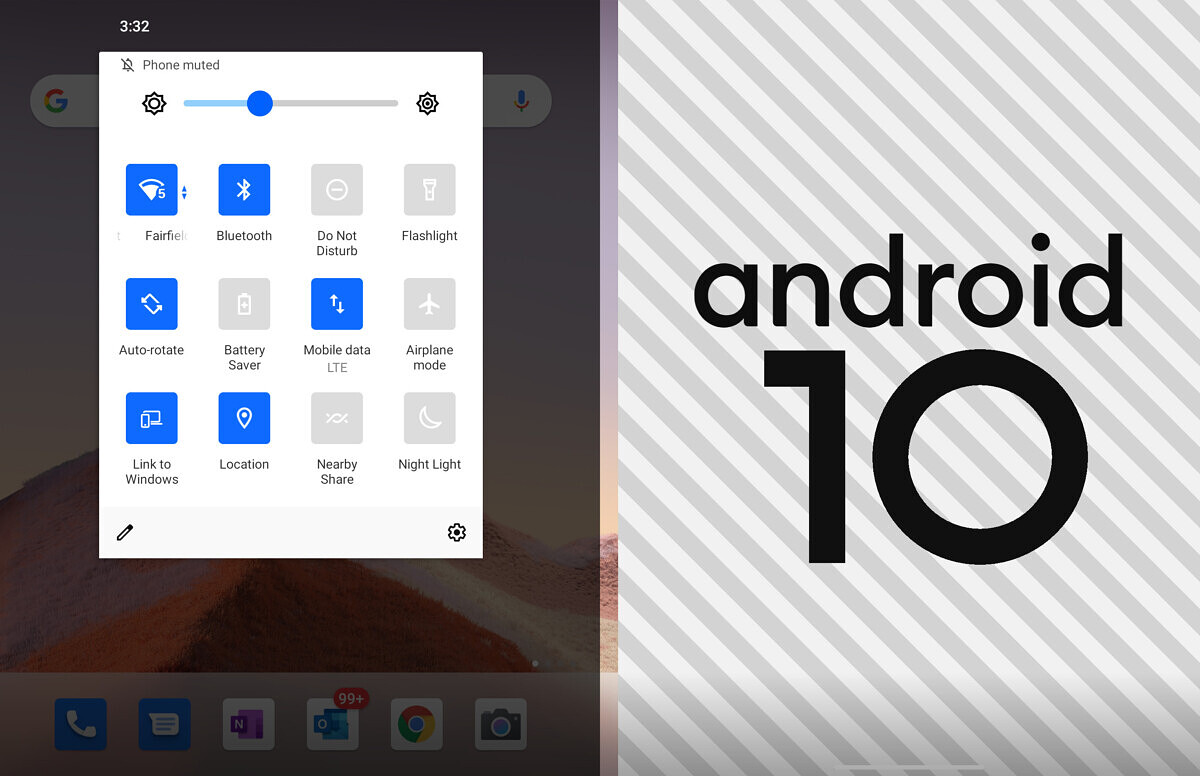
Along with that, Microsoft isn’t adding any features to the Surface Duo for dual-screen. That means no running the same app at the same time or anything unsupported by the app. The only system functions allowed are spanning, which is opening 1 app across both screens, and dual-screen mode. Spanning apps will allow you to do some sort of windowing, but the app needs to support it. Most apps don’t support it, but apps like Amazon Kindle and all of the Microsoft 365 suite do.
On the Kindle app, you can have it fill both screens and each screen acts as a single page. It makes reading more natural and feels like an actual book. It’s such a great experience. You can even put Kindle, or other eBook apps, on one screen and OneNote on the other for taking notes. I recently started my freshman year at college and have been doing this a lot recently. It works really well.
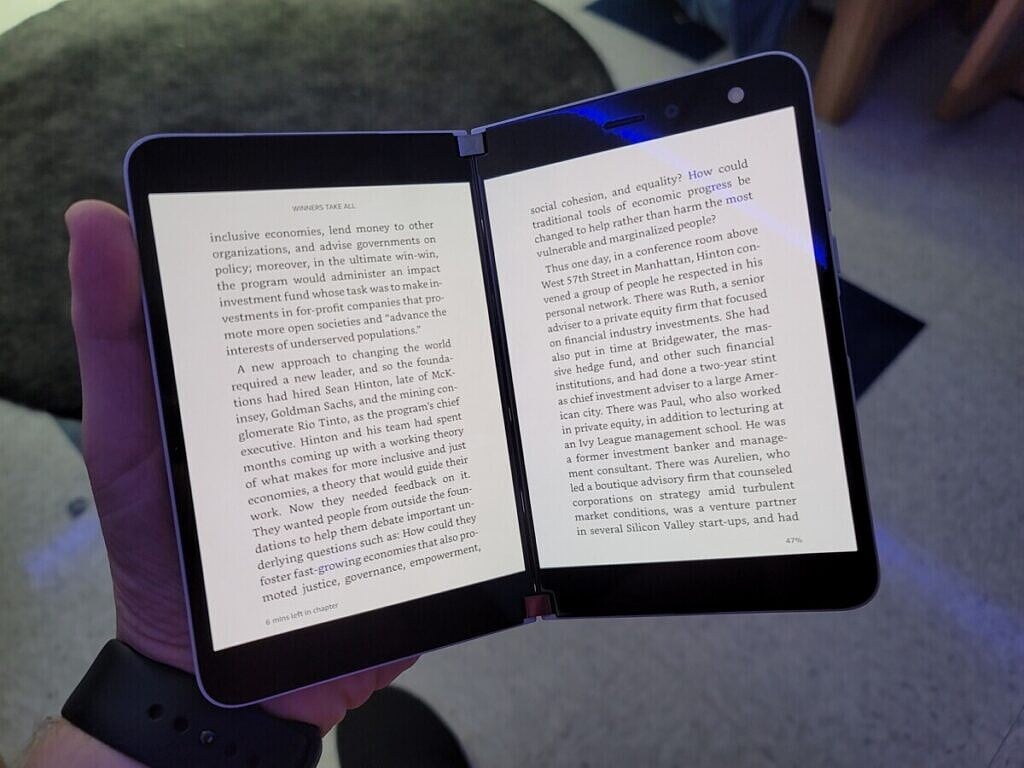
Another app setup I’ve loved using is Twitter and Zoom. As we are in a pandemic, some of my courses are fully online over Zoom, Teams, or Google Meet. As the fantastic student who is always paying attention, I love throwing one of the videos calling apps on the top screen with the camera and Twitter onto the bottom. What’s a class without the constant distraction of Twitter, after all? If you’re a better student than me, you might choose to throw OneNote or one of the many notes apps onto the bottom and take notes while watching Zoom calls. It works well, isn’t glitchy, and all-around feels more natural than the experience from a flat phone.
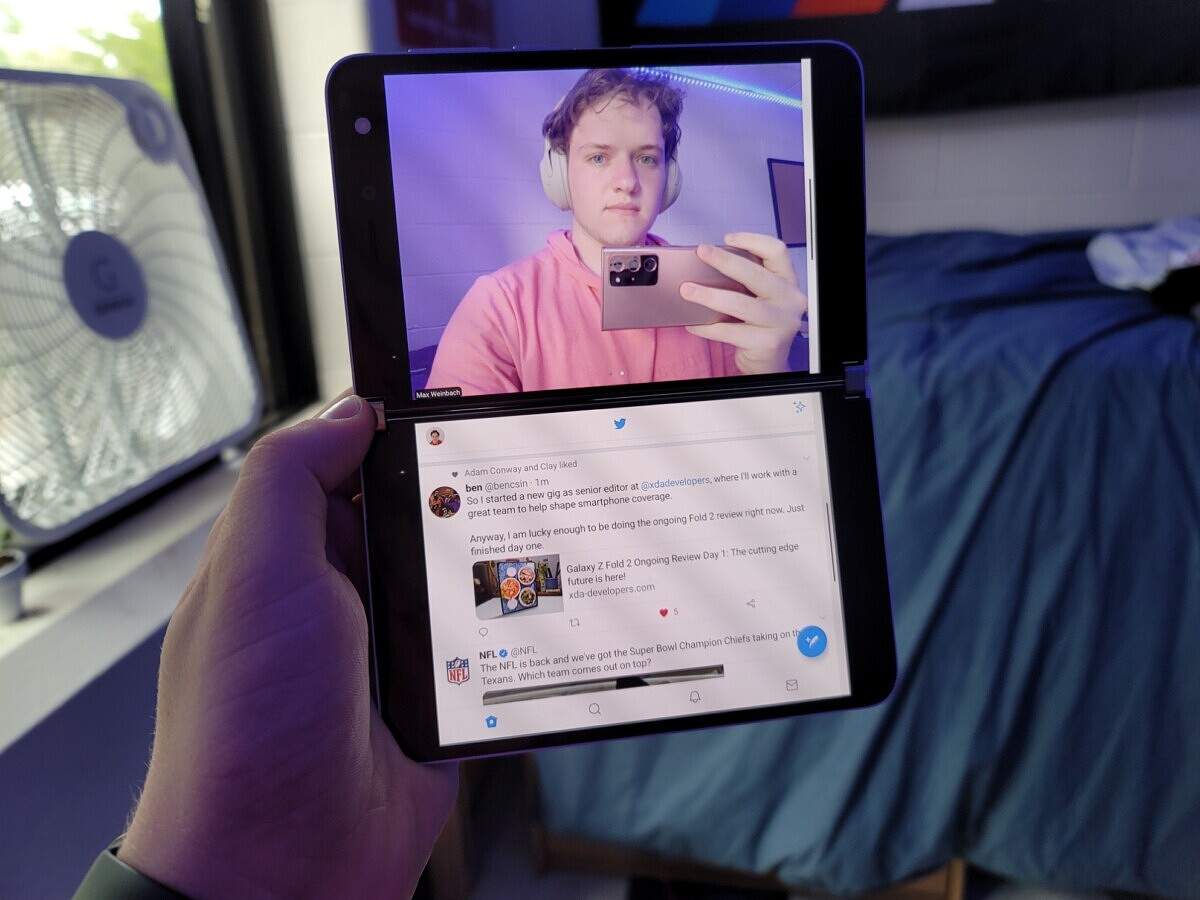
Getting into the system aspects of it, it’s a pretty simple experience. It runs Android 10 with the Microsoft UI on top. This means the launcher is Microsoft Launcher and it comes with all of Microsoft’s consumer-facing Microsoft apps pre-installed. The full list of pre-installed Microsoft apps is Microsoft Office, Outlook, Teams, OneDrive, Edge, OneNote, To Do, News, Authenticator, Bing Search, Intune, LinkedIn, Microsoft Solitaire Collection, and Surface Audio. There’s a little overlap between Microsoft and Google apps, and depending on your appetite, you might consider a bunch of these as bloatware.
Before we get into what the Surface Duo has, I feel like it’s worth going over what it doesn’t have. This is really only one thing: launcher support. It doesn’t have good support for third-party launchers. Every launcher I’ve tried just seems to either instantly crash, or work so poorly that it’s not worth it. Of course, the launchers can be updated to really support the dual-screen form factor, but that probably won’t be for a while. Until then, we’ll have to deal with the Microsoft Launcher, which really isn’t that bad.
Speaking about the Microsoft Launcher, it works in a really interesting way with the Duo. There are always two pages available, of course. These could be two pages of apps or a page of apps and the glance menu. From the launcher, you can access the system-wide search by swiping down on either side or you can access the app drawer by swiping up on either side. You can only have 1 app drawer open or 1 search bar open. To be honest, this is pretty self-explanatory.
Let’s move onto one of the more fun Surface Duo things: App groups! App groups are a little icon on the home screen that lets you open two apps at the same time. It’s very similar to Samsung’s app pairs, except this is a Microsoft phone and not a Samsung phone. When you app group icons, it opens both apps on the respective displays. It’s a simple but really useful feature that will let you choose the best app combination for you and launch it instantly in one click.
Something minor that I’ve also noticed that’s very annoying is with screenshots. As you can see in basically every screenshot above, it takes a full screenshot of both displays and has a little gap in the middle. This gap would be where the bezel and the physical hinge is on the device. Why is it like this? I don’t know. It’s just pretty weird.
Besides that, there’s really not much else to mention. There aren’t really any special features or distinctive anything. It’s just Android, but with two screens. I could go on for days about all the ways I use two apps at the same time, but honestly, it’s just repeating the same simple concept: the Surface Duo runs two apps at once. But because it is Android, it cannot run two instances of the same app at once. So if you have to work across two Word documents, or two Excel files at the same time, you have to do it in the same way as the rest of the Android ecosystem does it.
Camera
There isn’t all that much to the Surface Duo camera. It has a single 11MP front-facing sensor that becomes rear-facing when you flip the phone around and use the other display. It was designed for casual photography and video calling. It has a few different modes like panorama, portrait with adjustable depth control, and burst. It uses Super Resolution for up to 7x digital zoom and “auto mode with low-light & HDR multi-frame photo capture and dynamic range scene detection.” Basically, it can take still photos.
As for the camera quality, it’s fine. It’s not like you should be expecting the best of the best out of the Surface Duo. It has a single 11MP camera and the device wasn’t really designed to be a camera phone. It’ll look good in video calls or if you need to get a quick picture, but that’s about it. It doesn’t really compete against the Note 20 Ultra or Pixel 4a or even the OG Pixel.
On the video side, it supports 1080p and 4K at both 30 and 60fps with EIS. It does support video HDR at all modes, or at least it seems so from my testing. It does support slow motion as well, with 1080p at 120fps or 240fps.
The camera is fine and it’s just about acceptable for the type of device this is. It’s not meant to be the super-competitive foldable flagship like the Z Fold 2 — it’s a Surface. Microsoft prioritized a fantastic design and hardware experience over the camera. Am I happy about that? No, obviously not. I’d love for it to be better and more competitive. Do I understand the reason behind this first generation product? Yes, I do. It’s a productivity device meant for taking calls and checking emails, and let you get things done on the go. It’s not really the phone you’ll take on a vacation to get fantastic photos from the top of the Swiss Alps.
My Final Thoughts on the Microsoft Surface Duo
This final thoughts section is going to be all about the price. The Surface Duo starts at $1,399.99, or $1,400 if you want to keep things simpler. That’s a lot of money. That can get you a Galaxy Z Flip LTE, or a Galaxy S20 Ultra, or a Galaxy Note 20 Ultra, or a used Galaxy Fold, or two LG Velvet’s with dual-screen cases, or four Pixel 4a’s and a roll of duct tape, and so on. As I said, that’s a lot of money, and the Microsoft Surface Duo is by no means an inexpensive device. But like every $1,000+ smartphone, it’s not meant to be a good value. You should only buy it if you want it and you can afford it. It’s not a competitive, high value-for-money smartphone in the conventional sense of those terms, but it is an innovative device.
The Surface Duo is meant for a very specific group of people. It’s meant for Android users who use the Microsoft 365 suite regularly. To be honest, that probably isn’t you and I. It’s going to be the people on Wall Street, or maybe even students. It’s going to be those who can really make use of the dual-screen in a way that isn’t shallow. It’s the people who are going to throw up Outlook on one screen and Microsoft News on the other and spend their days on phone calls when they are not reading both. It’s the people who are fine spending $1,399.99 on a phone because it’s actually going to be useful for them. Or because they want something unique and want it to be a good talking point that can also get some things done while at it. Or maybe they want to do all of this, and are also looking for a device that will get three years of updates, is easily bootloader unlockable and has its factory images and kernel sources available.
Generally, it’s not a good sign when a phone gets categorized as a tool for a very specific set of users. Anyone should be able to pick up any phone and it should work for them. The Surface Duo isn’t really this phone, and it wasn’t even designed to be. It was made for the aforementioned group and I don’t think that’s necessarily a bad thing in this case. The Surface Duo is essentially a new form factor (pseudo-foldable) and both Microsoft and consumers need to figure it out.
Now, we get to the question I have a tough time answering: should you buy it? Probably not. Don’t get me wrong, the hardware punches above the spec sheet, and the software is getting there, but it’s more about the form factor than anything. This form factor is absolutely not for everyone. It’s for a very specific group of people. Those people know who they are and they should absolutely look into getting a Surface Duo. It is a fantastic device but this form factor isn’t conventional. There’s a learning curve and you should not get this device if you’re interested in the form factor only. You should only get this device if you’re actually going to take the time to sit down and learn the device and figure out how to maximize your own productivity.
Microsoft Surface Duo | $1399.99
- The Surface Duo is Microsoft’s first attempt at making an Android device. It’s got two screens, is super thin, and is a productivity powerhouse. If you want a mobile device that’s meant for work, the Surface Duo may be for you.
If you do want it, it’s available starting today in the United States and will be available in other countries soon. It’s available Unlocked from Microsoft and Best Buy along with carrier-locked on AT&T.
The post Microsoft Surface Duo Review: A multi-tasker’s dream appeared first on xda-developers.

